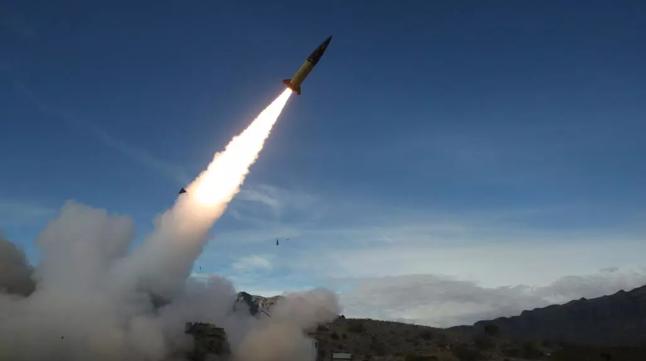
This article is more than
2 year old
Two months before leaving office, US President Joe Biden has lifted restrictions preventing Kyiv from using the Army Tactical Missile System (ATACMS) for strikes deep into Russian territory that could help defend its territorial gains in Russia's Kursk region. Today, Ukraine launched the US-made missiles onto Russian soil for the first time. Here's what you need to know about the long-range ballistic missiles.
In a reversal of longstanding US policy, US President Joe Biden on Sunday authorised Ukraine to use US-provided ATACMS missiles against military targets inside Russia. Washington had previously feared that allowing Ukraine to strike further into Russian territory would escalate the war, embroiling the US and other Western powers deeper in the conflict and possibly even provoking a nuclear response from Moscow.
On Tuesday, those missiles were used for the first time to strike inside Russian territory. Russia’s Defense Ministry said Ukraine fired six US-made ATACMS missiles early Tuesday at a military facility in Russia's Bryansk region that borders Ukraine, adding that air defenses shot down five of them and damaged one more. Senior Ukrainian officials confirmed that ATACMS were used in the strike.
Russian officials have repeatedly alleged that Western support for Ukraine amounts to “direct involvement” in the war and protested loudly about the “red lines” that Ukraine’s allies should not cross in providing military aid.
But Ukraine's use of ATACMS and comparable weapons in Crimea or the Donbas suggests that strikes using these conventional weapons have been “priced in” to the Russian war effort, according to Matthew Savill, military sciences director at the Royal United Services Institute (RUSI), a London-based think tank.
What are ATACMS missiles?
The Army Tactical Missile System (ATACMS) was created during the Cold War to strike Soviet targets but were first used during the 1990-1991 Gulf War.
They have already been used by Kyiv during the war in Ukraine, but only on targets in Russian-occupied areas such as Crimea and the Donbas region.
Ukrainian forces used US-supplied long-range ATACMS missiles for the first time in October 2023, with President Volodymyr Zelensky saying the weapons had "proven themselves".
Warhead
The missile has a 230kg high-explosive warhead to target troop concentrations, airfields and support facilities. A variant carries cluster munitions – up to 300 bomblets that are ejected and designed to kill troops and destroy equipment.
Savill noted that the ATACMS can be launched from the US High Mobility Artillery Rocket System (HIMARS), of which Ukraine has several.
Range
These missiles can reach deeper into Russian territory than any other missile in Ukraine’s arsenal, but have a shorter range than cruise or intercontinental ballistic missiles. Standard HIMARS rockets have a range of up to 70km, and conventional artillery like the howitzer has a range of about 40km.
Ukraine is said by military analysts to have the ATACMS version M39A1 Block IA that are guided in part by Global Positioning System (GPS) and have a range of 70 to 300km, Reuters reported.
Ukraine is also believed to have M57 ATACMS that deliver a single 500-pound (230-kg) high-explosive warhead at a range of 70 to 300km. The M57 was first used in 2004 and has been used in several conflicts, including Operation Enduring Freedom in Afghanistan, according to US Army documents.
Speed
ATACMS are ballistic missiles initially powered by a rocket into the atmosphere before falling back to the ground at incredibly high speed to reach its intended target.
The ATACMS missile travels at Mach 3, or three times the speed of sound – 3,700km per hour – as it streaks towards its target, making it much much harder for Russian missile defences to intercept than non-ballistic missiles or drones.
How does ATACMS compare with other missiles in Ukraine’s arsenal?
France and Britain have provided SCALP and Storm Shadow cruise missiles, which are launched from aircraft and have a range of 250km. But neither government has spelled out whether they would follow the US lead and allow Ukraine to use them for longer-range, cross-border strikes.
According to Davis Ellison, strategic analyst at the Hague Centre for Strategic Studies, employing drones along with ballistic or cruise missiles “has been a hallmark of the war".
"Used in combination, they can overwhelm air defence systems to ensure the heavier payload of the missile strikes the higher-value target,” he said.
Targets
In August, the Institute for the Study of War and Critical Threats – two North American think-tanks providing daily analyses of the Ukraine conflict – created an interactive map detailing '225 known military targets' potentially within reach of ATACMS strikes.
Russia has moved many high-value targets – helicopters and glide-bomb armed aircraft attacking Ukrainian cities “to airbases outside the range of ATACMS”, RUSI's Savill said. But there are many other sites Ukraine could target, such as “military headquarters and ammunition or supply locations supporting Russian and North Korean troops”, he added.
Combined with existing standard rockets capabilities, ATACMS may help the Ukrainians hold on to the territory they occupied in Russia’s Kursk region, “in the face of Russian counter-attacks and inflict casualties on those North Korean forces that are now operating inside Russia,” Savill said.
UK-French capabilities
The US authorisation on the use of ATACMS will enable the UK and France to grant Ukraine permission to use comparable European missiles inside Russia. The Storm Shadow, known as SCALP in France, is a Franco-British long-range cruise missile with similar capabilities to the US ATACMS.
Since these missiles are equipped with US-made GPS targeting systems, Ukraine needs US approval to use them inside Russia, according to Huseyn Aliyev, senior lecturer and specialist in the Ukraine war at the University of Glasgow. The relaxation on restrictions on using ATACMS should lead to a similar easing of restrictions on using Storm Shadow and SCALP, Savill said.
Cost
Each ATACMS missile costs about $1.5 million. The comparable Franco-British missile the Storm Shadow, or SCALP, costs about $1 million.
Political impact
It is unlikely that Ukraine’s new missile capability will have “a major impact” on convincing the incoming administration of Donald Trump that the country is still worth backing, Savill said, given the many Ukraine sceptics in the Trump camp and the short time frame until the formal presidential inauguration on January 20.
But not everyone is convinced that Ukraine’s new missile capability is a case of too little, too late, including John E. Herbst, senior director of the Atlantic Council’s Eurasia Center in Washington, and former US ambassador to Ukraine from 2003 to 2006.
“Russian President Vladimir Putin desperately wants to take back all occupied Russian territory,” he wrote on Monday, referring to Ukraine’s incursion into the Kursk region. “The longer-range Western weapons may make this notably harder for Putin to achieve. That would enhance Kyiv’s leverage in future talks.”
President Vladimir Putin responded to Biden's authorisation of ATACMS strikes into Russian territory today by formally lowering the threshold for Russia’s use of its nuclear weapons. The new doctrine states that a nuclear retaliation would be possible even in response to a conventional attack on Russia by any nation supported by a nuclear power.
When asked Tuesday whether a Ukrainian attack with US-provided long-range missiles would potentially trigger a nuclear response, Kremlin spokesman Dmitry Petrov said that it could.